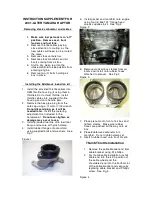
INTRODUCTION
PRELIMINAR STUDIES AND CONSIDERATIONS
MAINTENANCE AND DAMAGE PREVENTION
WORK ON BASIC VEHICLE
MOUNTING AND CONSTRUCTION
POWER TAKE-OFF
ELECTRIC AND ELECTRONIC SYSTEMS
APPENDIX
V1.0, February 2015
Body Builder Manual Part II, Specific Book LCV
37
2.3.6
Vehicle overhang
In some situations it may be necessary to exceed the length of rear overhang of the
vehicle. In these cases, the guidelines presented in this manual must be followed.
Before tackling the task of modification the rear overhang, ithe different parame
-
ters or values which may be affected by this modification must be analysed, in order
to ensure that they remain within the permissible limits.
The most important points to consider are:
Maximum permissible dimensions of the vehicle:
The final dimensions of the vehicle should be checked once the modification work
has been undertaken, in order to be sure that they are within the permissible limits.
See chapter 2.3.2 "Vehicle main dimensions".
Maximum permissible weight on axles:
Once the modification of the vehicle has been completed, the weight on axles must
be within the permissible limits. Special attention must be paid to the minimum load
on the front axle.
See chapter 2.3.3 "Weight distribution".
Centre of Gravity (CoG):
Modifying the wheelbase can cause displacement of the centre of gravity. A check
must be carried out to ensure that the new position of the CoG is located within the
permissible areas.
See chapter 2.3.4 "Centre of Gravity (CoG)".
Chassis material:
The materials used for the elongation of the chassis must be of at least the same
quality as the originals.
See chapter 4.2.2 "Materials".
The dimensions must also match the originals.
See chapter 4.2.3 "Main sections".
Positioning of the coupling device:
The suitability of the new position of the coupling device should be considered, en
-
suring that this complies with the normative. Also, the effect on the weight distri
-
bution on the axles must be studied.
See chapter 4.7 "Coupling device adaptations".
Rear underride:
A check should be carried out to see whether the new position complies with the
rear underride standard.
See chapter 4.12.2 "Underride guards".
















































